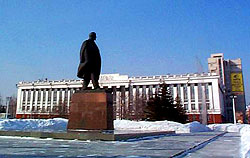About Barnaul
 Barnaul is the capital of Altay Territory, south-western Siberian Russia, on the Ob River, one of the oldest cities in Siberia. A port and major railway junction, Barnaul is in the heart of the Kulunda steppe, an agricultural area where wheat, corn, and sugar beets are grown.
In the 18th and early 19th centuries 90% of Russian silver - 16.5 tons annually - was produced in the Altay. The Barnaul silver-smelting works with 13 of its furnaces was considered to be the largest one, the silver production amounted there to 7.4 tons a year. No wonder the small works settlement kept growing and in 1771 it acquired the status of a mining town that was one of the largest in Siberia. The name "mining town" was not haphazard - all the aspects of the town's life were focused on mining production.
Today the city's chief industries produce cotton textiles, chemicals, artificial fibres, and machinery.
The city has five theatres, a Philharmonic Society, three museums, twelve Palaces and Houses of Culture, ten musical and art schools, thirty the municipal libraries with a total of 1200000 books. There is a Palace of Sports, Sport Complex "Ob", stadiums, sport centers, swimming pools and a hippodrome.
Barnaul is the capital of Altay Territory, south-western Siberian Russia, on the Ob River, one of the oldest cities in Siberia. A port and major railway junction, Barnaul is in the heart of the Kulunda steppe, an agricultural area where wheat, corn, and sugar beets are grown.
In the 18th and early 19th centuries 90% of Russian silver - 16.5 tons annually - was produced in the Altay. The Barnaul silver-smelting works with 13 of its furnaces was considered to be the largest one, the silver production amounted there to 7.4 tons a year. No wonder the small works settlement kept growing and in 1771 it acquired the status of a mining town that was one of the largest in Siberia. The name "mining town" was not haphazard - all the aspects of the town's life were focused on mining production.
Today the city's chief industries produce cotton textiles, chemicals, artificial fibres, and machinery.
The city has five theatres, a Philharmonic Society, three museums, twelve Palaces and Houses of Culture, ten musical and art schools, thirty the municipal libraries with a total of 1200000 books. There is a Palace of Sports, Sport Complex "Ob", stadiums, sport centers, swimming pools and a hippodrome.

























